Heightening Healthcare Through Medical Imaging Software Development
02 Aug 2023
14 Min
651 Views
With the increasing volume of medical data and technological advances, medical imaging is fundamental in supporting diagnosis, decision-making, and patient care. Such systems significantly improve the efficiency of medical practice and treatment outcomes, driving the demand for medical imaging software development. Market research platform MarketsandMarkets states that diagnostic imaging market size is projected to reach USD 35.0 billion by 2026, at a CAGR of 5.7%.
As an IT provider with over 11 years of industry experience in healthcare software development, we at Cleveroad are here to help you understand how custom medical image analysis software works, how you can benefit from it, and what key features to include to make the system effective.
How Does Medical Imaging Software Work?
Medical imaging software is a specialized tool designed to analyze and visualize medical data obtained through various techniques (radiography, ultrasound, etc.). Healthcare providers use medical image analysis software solutions to make accurate diagnoses and plan treatment. Let's examine how such software works:
1. Image acquisition. Medical images can be obtained in various ways, such as radiography, ultrasonography, magnetic resonance imaging (MRI), etc.
2. Image processing. The resulting images may contain noise and artifacts that can affect the accuracy of the diagnosis. Therefore, the second step is image processing. This may include filtering, contrast enhancement, brightness equalization, and other techniques that help improve the image's quality.
3. Image analysis. Depending on the type of research and task, medical image analysis software solutions can detect abnormalities (e.g., tumors), highlight them in color, or indicate their exact coordinates.
4. Visualization and interpretation. Medical images can be presented in various formats, such as two-dimensional images, three-dimensional reconstructions, or volumetric models.
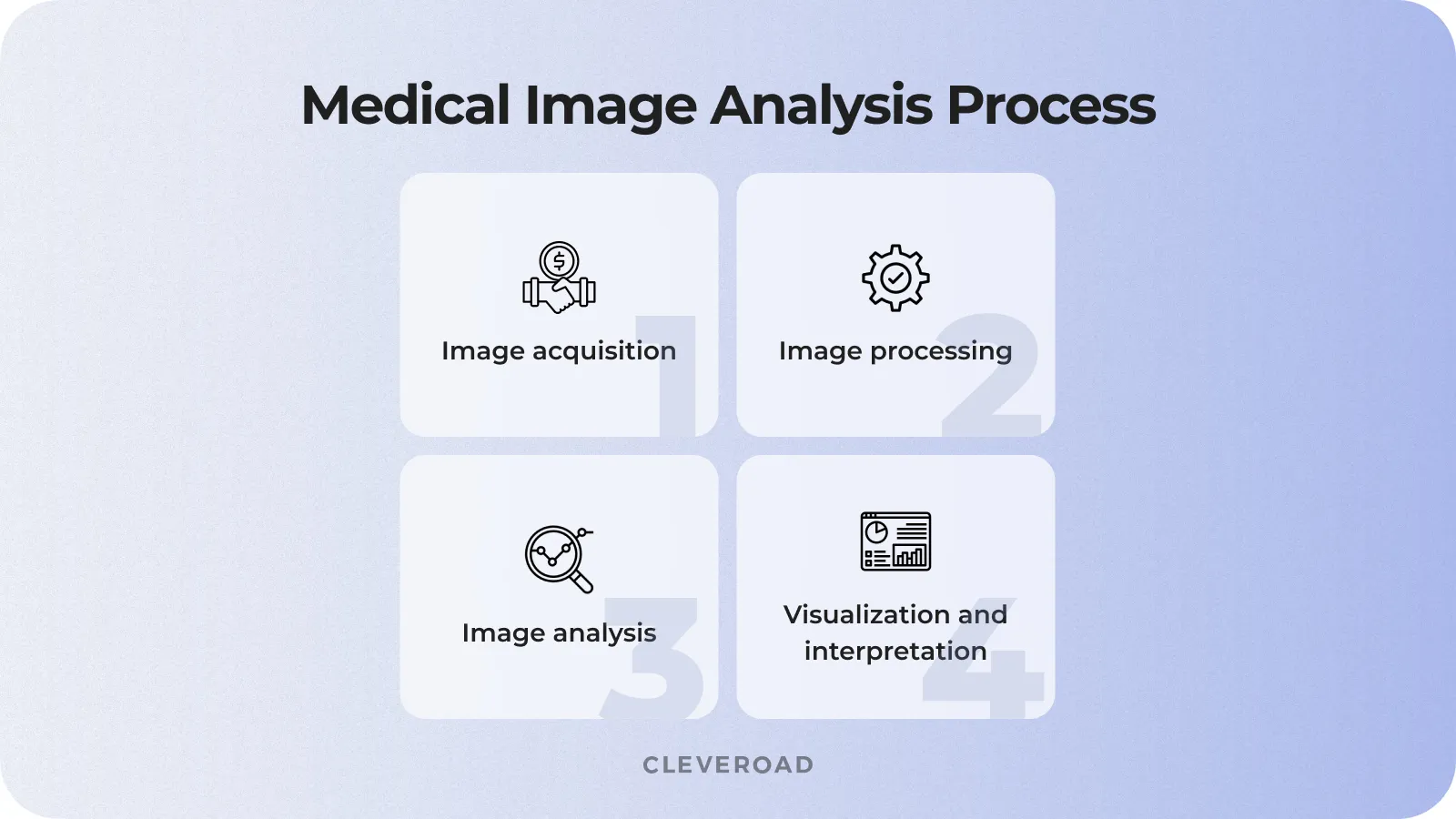
Medical imaging software work principle
Applications of Medical Image Analysis Software in Clinical Practice
Custom medical image analysis software is used in a multitude of healthcare departments, allowing physicians to improve diagnosis and plan treatment more effectively. Let's take a look at some of the examples of such software applications:
Cardiology. Medical image analysis software solutions can analyze heart images and detect abnormalities. Thanks to such diagnostics, doctors can detect a disease before it reaches a critical stage, which will significantly increase the effectiveness of treatment.
Oncology. Medical image analysis software is critical in oncology diagnosis and treatment because it can help determine the stage and type of cancer, allowing for more accurate treatment planning.
Neurology. In this field, this software can analyze brain images and diagnose neurological diseases such as stroke, epilepsy, and Parkinson's.
Dental medicine. Image analysis solutions are used in dentistry to analyze dental and jaw X-rays. Such solutions can help diagnose dental caries, orthodontic problems, and other dental diseases.
Ophtalmology. Medical image analysis software can help diagnose eye diseases such as glaucoma, cataracts, and retinal degeneration.
These are just some examples of medical image analysis software solutions, as this technology is used extensively in healthcare, and most departments utilize it more or less.
Explore how telemedicine software development services will help you build a medical software for better care delivery
The Core Features of Custom Medical Image Analysis Software
Custom medical image analysis software solutions can vary significantly in their functionality depending on the additional requirements of specific institutions. However, a few basic features must be included for effective medical imaging software development.
Image quality enhancement
The image enhancement feature optimizes and improves medical images' clarity, contrast, and resolution. This tool facilitates more accurate and detailed visualization of anatomical structures and pathological changes, which helps medical providers make more precise diagnoses and informed treatment decisions.
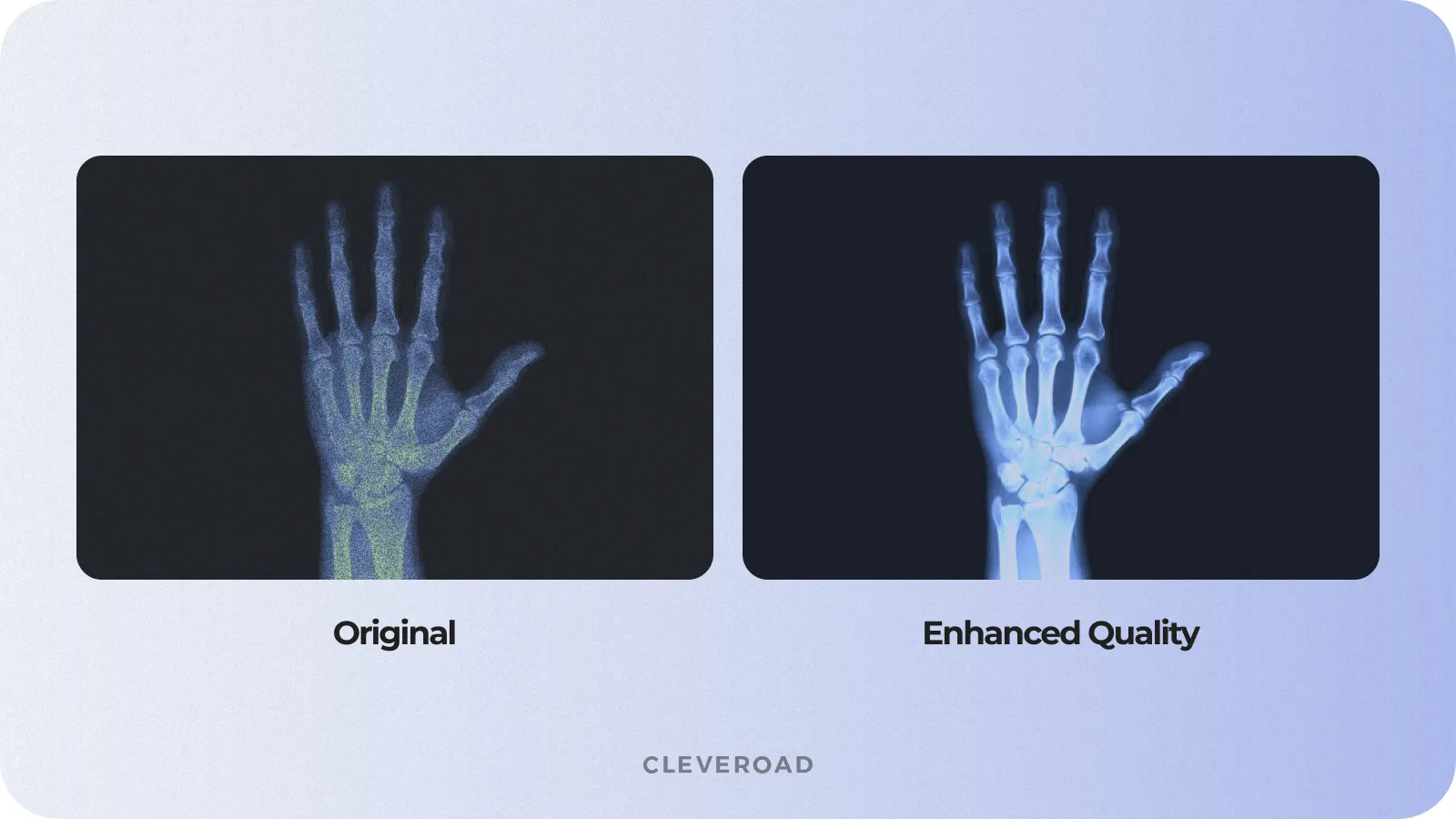
Quality enhancement feature example
Image segmentation
This feature allows caregivers to highlight and separate areas of interest in medical images automatically. For example, when analyzing magnetic resonance images, the software can highlight a specific organ or tumor, which simplifies analysis and helps doctors more accurately identify pathological changes.
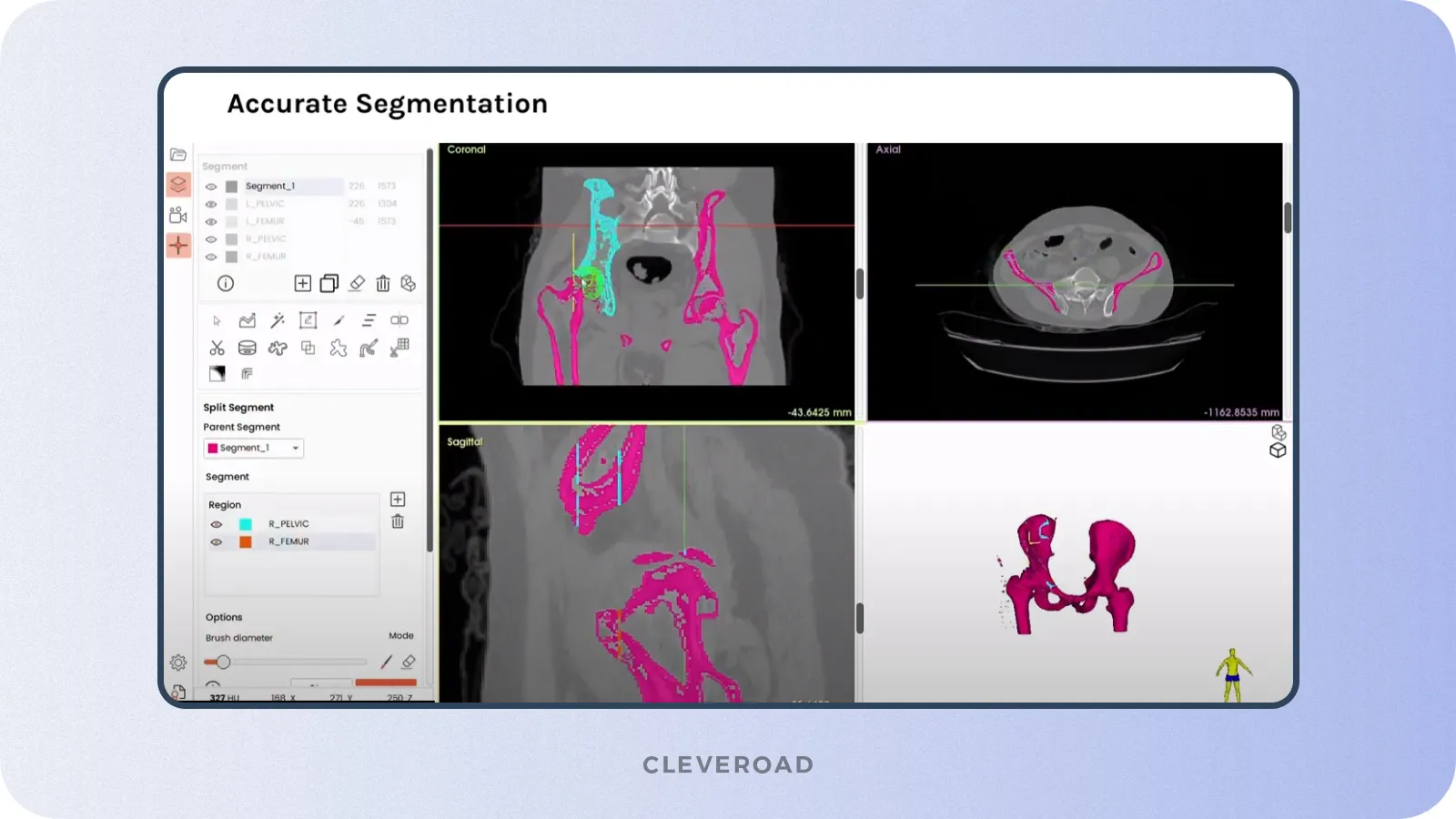
Image segmentation feature example
Image registration
The image registration function combines multiple medical images acquired in different planes or time points into a single 3D or 4D model. This feature allows healthcare providers to obtain an accurate picture of anatomical structures or pathologic changes, which is important when planning complex surgical interventions.
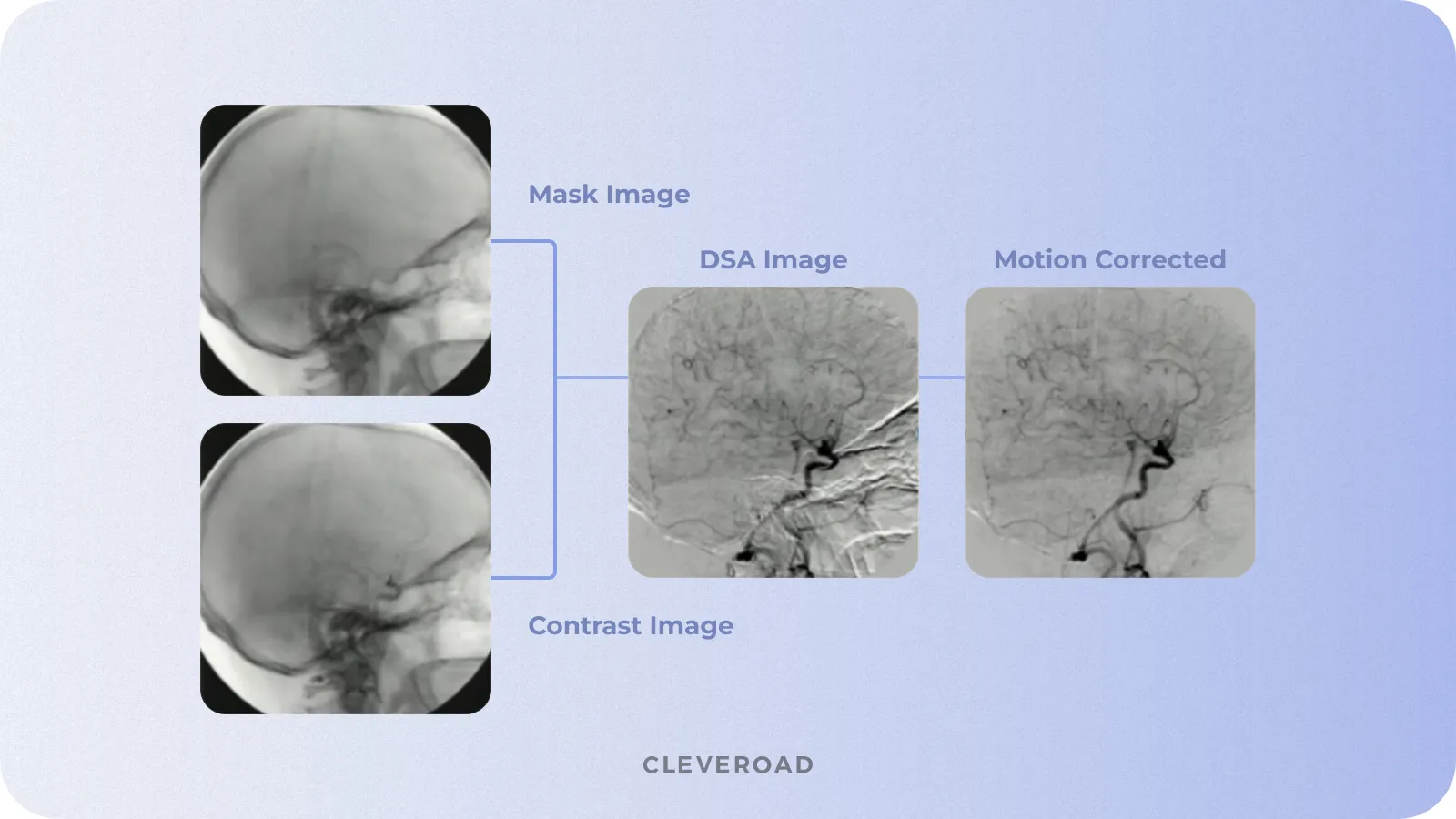
Image registration feature example
Quantification
This feature allows for quantitative measurements of medical images, such as tumor sizes, organ volumes, or the extent of changes to anatomical structures. Quantification provides more objective data for analysis, which helps physicians to determine the extent of disease and the effectiveness of treatment.
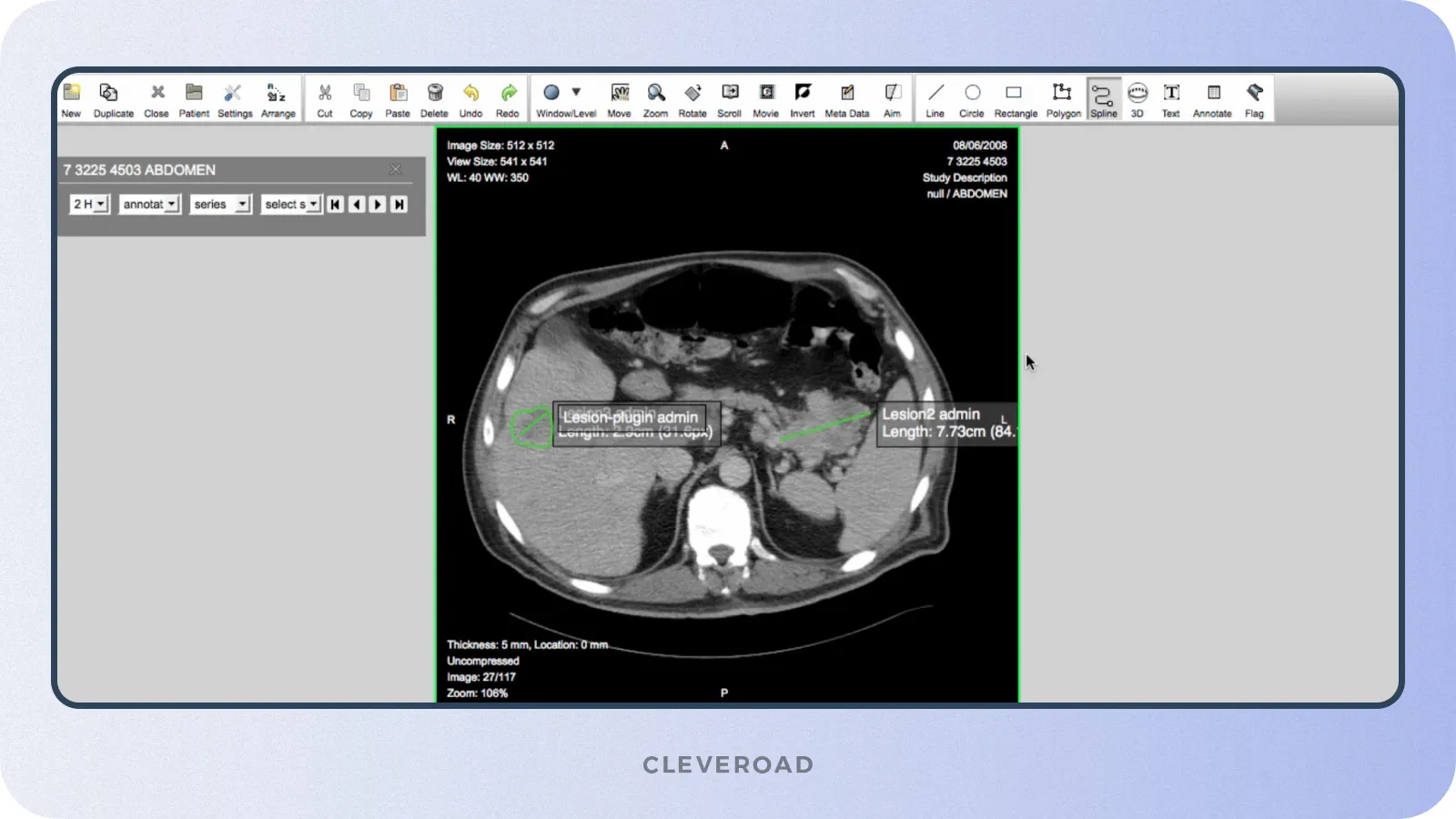
Quantification feature example
3D reconstruction and 2D visualization
The 3D Reconstruction feature creates three-dimensional models of anatomical structures or organs, making it easier for doctors to understand and visualize complex anatomical relationships. 2D visualization, in turn, provides detailed 2D images for more accurate analysis and diagnosis.
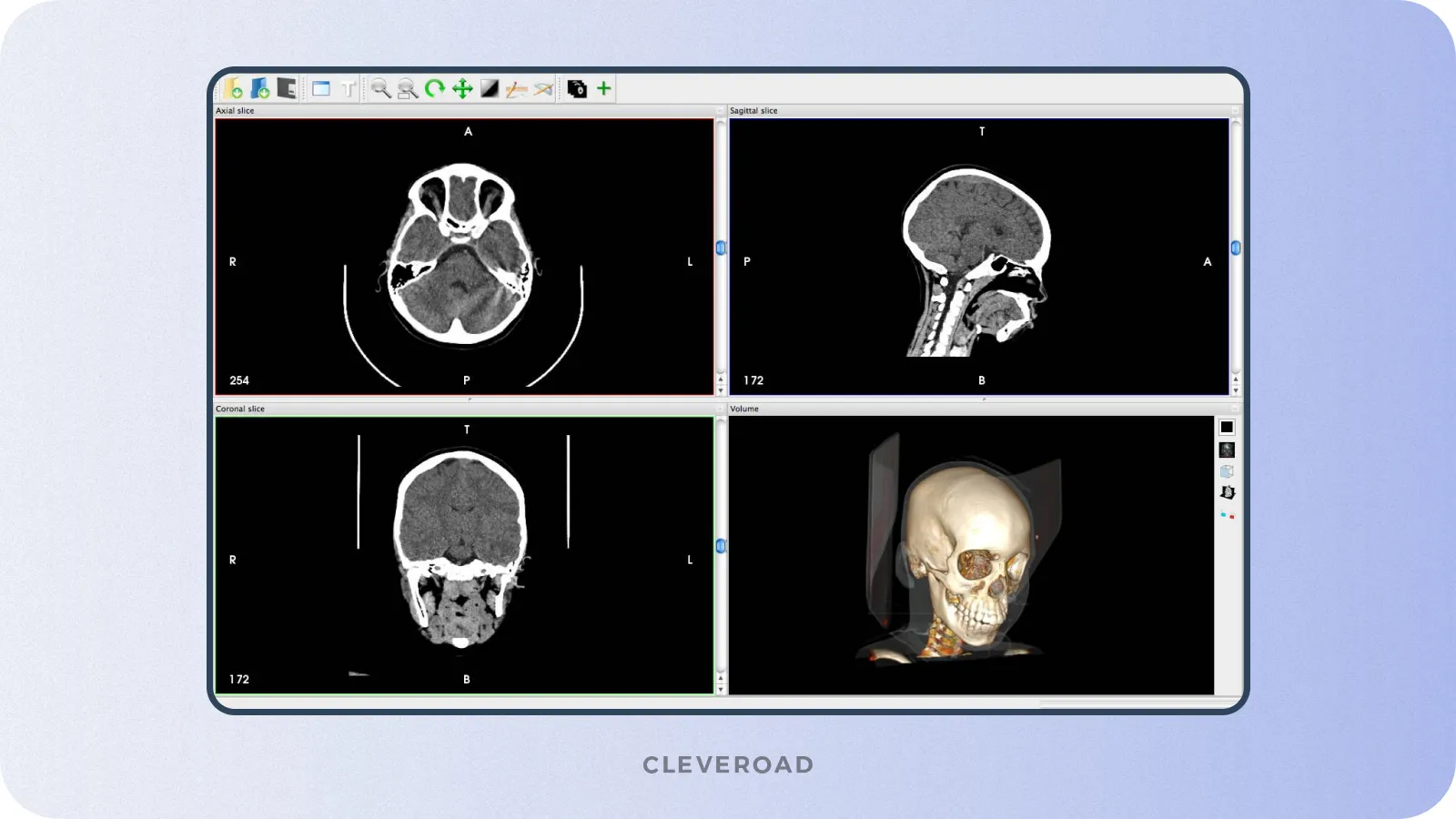
3D reconstruction feature example
These are key features that should be included in medical image software for efficient analysis of medical images. This list can be supplemented with other features depending on your needs and your medical team's requirements for such software.
Challenges of Medical Imaging Software
Medical imaging software development is a tough and demanding process which may be associated with several challenges. Let's take a look at the main ones and find out how to you can overcome them:
Security and compliance
Medical images contain sensitive patient info, including personal data and medical history. Therefore, ensuring this data's security and privacy is paramount for medical image analysis software development. To ensure this point is manageable for you, it is worth working with an experienced vendor with extensive experience securing medical data and complying with relevant standards such as HIPAA, GDPR, SO/IEC 27001, ISO/IEC 27799, NIST, PCI DSS, etc.
We, at Cleveroad, have practical experience in creating healthcare software that will be subject to the industry regulation and standards (e.g. HIPAA, PIPEDA, GDPR, FDA, FHIR, etc.) to ensure the secure data transfer and its safety.
Explore how to build a HIPAA compliance software so you can use it without legal risks
Technical complexity
Medical imaging software requires processing large amounts of data and complex image processing algorithms. This can be technically challenging for developers, especially those who don’t possess the required expertise. Proper processing and analysis of medical images requires high performance and efficiency of the software to ensure accurate and reliable results. Therefore, it is essential to partner with an experienced tech vendor specializing in telemedicine software engineering to ensure that the solutions developed are high quality and efficient.
Lack of expertise
Medical software development requires high skills and specialized knowledge in the Healthcare domain. Therefore, it is crucial to take a conscious approach to finding the right provider for you. You can create your own in-house team, expand the current one with the right expertise, or outsource product development to 3rd-party firms. But, you may have difficulties finding software engineers in your area capable of developing such a complex medical solution.
This way, you can turn to an external medical image analysis software development company to access tech talents from other regions. Moreover, you can choose the cooperation model that suits your needs.
- Outstaffing. This model allows you to optimize team costs by augmenting your internal team with the necessary specialists from other regions. For example, you may need a backend developer, a frontend developer, and 1 QA to work on medical image software. This cooperation model allows you to reduce time and resources for hiring specialists and get the necessary expertise within a week .
- Outsourcing. By outsourcing medical image analysis software development services, you can get managed IT services from a 3rd-party company. Applying this model will give you a team of specialists fully responsible for the development process and product quality. There are daily and weekly check-up meetings where you review how the process is going on. By choosing this model, you can significantly reduce costs due to faster development as well as cost-effective rates in some regions, and gain access to tech talents and technology worldwide.
Resistance of clinical staff to embark on new technologies
Implementing a new digital solution can cause resistance among your clinic staff due to lack of experience and fear of embracing something new. Failure to utilize a new imaging app may result in missing out on benefits such as accurate diagnosis and improved treatment planning. To overcome this issue, you should train your staff by explaining how the new software works, providing guides and tutorials. Support and assistance from your software vendor at the implementation stage will help you ensure the successful medical imaging system integration into your business environment.
Medical Imaging Software Development Process
Let's look at the basic steps of medical image analysis software development you must go through to get a successful solution.
1. Assess your healthcare organization's needs
To ensure the success of your medical imaging software development product, you should start with a thorough assessment of your medical organization's needs. Engage in meaningful discussions with your medical and administrative staff to understand their pain points, challenges they face while providing healthcare services.
Listening to your staff's feedback and understanding their day-to-day workflow will guide you in determining the core objectives of the medical imaging system. Whether improving diagnostic accuracy, streamlining image acquisition, enhancing collaboration, or optimizing patient data management — having a clear set of goals will ensure that the final solution aligns with your - strategic vision.
2. Find an experienced tech partner
The next critical step is to find an experienced healthcare software provider. When choosing a medical image analysis software development company, pay attention to relevant expertise, proficiency in medical software development, experience in delivering legislation-based solutions, portfolio with healthcare and telehealth solutions, etc. You can find reliable software providers on the professional platform such as Clutch. You can come to the company’s profile and get relevant info about services, project’s budget and real client’s feedback.
3. Define product requirements
Once you find a software provider, the development team conducts a detailed definition of your product’s requirements. Together with your vendor you also decide whether you need a standalone medical imaging system or integrated solution into your healthcare system. The team also defines functional and technical requirements, including types of medical images, formats, supported processing algorithms, and data security and privacy requirements. The entire planning process and requirements gathering is based on your organization’s workflow and primary business needs.
4. Develop a system based on the requirements
Based on defined requirements, developers start creating medical software. But the development approach will differ depending on whether you want to build an autonomous medical image software or integrate the solution into your existing healthcare management systems.
If you decide to develop a standalone solution, it’s recommended to start with MVP development to validate your product's idea. MVP (Minimum Viable Product) is the version of custom medical image analysis software that contains only the essential features required to ensure the functionality of the app and meet the basic users’ needs. Such an approach allows you to quickly deliver software with minimal investment, ensure it is viable, and gather feedback from your medical staff. Further, you can allocate funds to develop a fully-fledged solution based on the results and users’ feedback.
In case you need to integrate a medical imaging software module into your existing healthcare systems, the team creates a proof of concept (POC). This method allows for ensuring the new module is compatible and effectively integrates with key business management systems:
- Electronic Health Records/Electronic Medical Records (EHR/EMR)
- Hospital Information System (HIS)
- Radiology Information System (RIS)
- Picture Archiving and Communication System (PACS), etc.
Regardless of the chosen approach, the main task of a medical image analysis software development company will be to create a functional and user-friendly solution. Therefore, developers may use such tools as medical imaging interaction toolkit and several healthcare APIs, to ensure successful development and integration. Moreover, QA engineers perform several tests during and after development to ensure all features work correctly.
5. Implementation, support, and training
Once the medical imaging software is developed, the next step is to implement the solution into your clinic’s infrastructure. Your trusted technical partner will play a pivotal role in this process, ensuring a seamless integration that minimizes disruptions to your workflow. They will work closely with your team to deploy the software efficiently and configure it to meet your specific requirements.
Even after implementation, you may need tech support due to the solution’s complexity. Your vendor will remain a reliable point of contact, providing ongoing technical assistance and support. You can turn to your tech provider whenever you encounter any issues or have questions about the software's functionalities. This ongoing support ensures that your custom medical image analysis software operates at optimal performance and allows you to focus on delivering high-quality patient care without disruptions.
6. Monitoring, performance evaluation
Once medical software is implemented, monitoring its performance and impact on the clinical processes is vital. Perform regular evaluation of the results and effectiveness of the system. If necessary, you can ask your IT partner to make improvements and adjustments based on feedback from your staff. So you can maximize the benefits of your medical image processing software.
If you need professional medical image analysis software development services, turn to us. We have been developing healthcare and telemedicine solutions since 2011 and can assist you in creating a medical imaging system for better diagnosis. Let us tell you more about our experience in the healthcare industry and what medical IT services we offer.
Cleveroad - Your Reliable Medical Image Analysis Software Development Company
Cleveroad is a healthcare software development company with over 11 years of experience in the IT industry. We create various healthcare solutions, such as medical imaging software, data visualization tools, EHR/EMR, systems, patient portals, telemedicine solutions, remote patient monitoring platforms, etc. Our company helps clients worldwide to digitize and optimize workflows at medical facilities.
By partnering with us, you will receive the following benefits:
- Practical experience in developing healthcare solutions that consider the security and interoperability standards, such as GDPR, HIPAA, PIPEDA, HITECH, HL7, CDA, CCD and other regulations
- Services on demand: healthcare software development from scratch, legacy system modernization, managed IT services, IT consulting, cloud development, IoT integration, etc.
- Quality assurance from experienced QA engineers at all stages of development
- In-depth consultation with our Senior Business Analysts and Solution Architects with solid experienced in healthcare
- Signing a Non-Disclosure Agreement (NDA) per your request
Our portfolio contains many healthcare and telemedicine software solutions and now we would like to introduce you to some of them.
An IoT-based System for Monitoring EKG and Blood Oxygen Levels is an example of such a solution. We developed the telecare software allowing end users to measure ECG and check oxygen concentration in their blood from mobile devices. The solution comprises mobile apps for iOS and Android: establishing connection (via Bluetooth) with the company's pulse oximeters and IoT devices. The system meets the requirements for HIPAA and FDA for securely storing and processing of e-PHI data. Our team also integrated an e-commerce module to the customer’s website, so the client can sell their medical IoT hardware online.
Another solution developed by our team is the Clinic Management System, created for a US-based rehab clinic that offers remote care and online consultation. It's a telecare platform with EMR and mobile apps for healthcare providers and patients. The system contains the appointment booking module, access to the SOAP notes and other clinical info, an accounting system, and a notifications service. We’ve also used the AES-256 encryption algorithm, several security and data privacy tools around access, and use of sensitive health info and deployed the platform to AWS to ensure HIPAA compliance.
We also created a custom Telemedicine Appointments Management System for our client, a UK-based provider of healthcare consultations. It’s a solution for delivery of remote healthcare services with RBAC control that meets the demands of security standards (GDPR, UK KYC policies) and core healthcare regulations (MHRA and CQC). Solution included online access to general practitioners and clinicians with the ability to make same-day appointments, quick applying for telemedicine services for patients, video and audio appointments, e-prescriptions, referrals, sick notes, online sessions, and Doctors' and Patients' management by the administration.
If you are considering medical imaging software development, Cleveroad is ready to help you. Our team will provide you with expert tech assistance and a robust medical image analysis system, which allows you to improve diagnostics and treatment planning.
Build your medical imaging software
Get a medical imaging solution from team with 11+ years of expertise in healthcare development
Medical imaging and visualization software are advanced digital tools designed to capture, process, and display visual representations of internal body structures and organs. These images, acquired through various medical imaging modalities like X-rays, CT scans, MRIs, and ultrasound, aid healthcare professionals in diagnosing and treating medical conditions effectively.
Medical imaging software includes a range of specialized applications that healthcare professionals use to view, analyze, and interpret medical images. Some commonly used medical imaging software includes Picture Archiving and Communication Systems (PACS), Radiology Information Systems (RIS), 3D image reconstruction software, and image analysis and processing tools.
Medical imaging software typically offers essential features like image capturing and storage, image enhancement and manipulation, 3D reconstruction, and integration with electronic health records (EHR) systems. Additionally, advanced medical imaging software may include artificial intelligence (AI) capabilities for automated image analysis and computer-aided diagnosis.
Medical image analysis software is pivotal in modern healthcare by revolutionizing diagnostics, treatment planning, and patient care. Its impact includes faster and more accurate diagnosis, enabling early detection of diseases, personalized treatment planning, and enhanced surgical precision. With AI-powered algorithms, medical image analysis software can automate tasks, reduce human errors, and improve overall efficiency in medical practices, ultimately leading to better patient outcomes and a more streamlined healthcare system.

Evgeniy Altynpara is a CTO and member of the Forbes Councils’ community of tech professionals. He is an expert in software development and technological entrepreneurship and has 10+years of experience in digital transformation consulting in Healthcare, FinTech, Supply Chain and Logistics
Give us your impressions about this article
Give us your impressions about this article